Report on Managerial Accounting Principles and Practices
VerifiedAdded on 2022/11/28
|6
|1769
|158
Report
AI Summary
This report provides a comprehensive overview of managerial accounting, encompassing key concepts such as cost accounting, cost classification, and cost drivers. It explores various costing methods, including job order costing and process costing, and delves into the calculation of equivalent units. T...
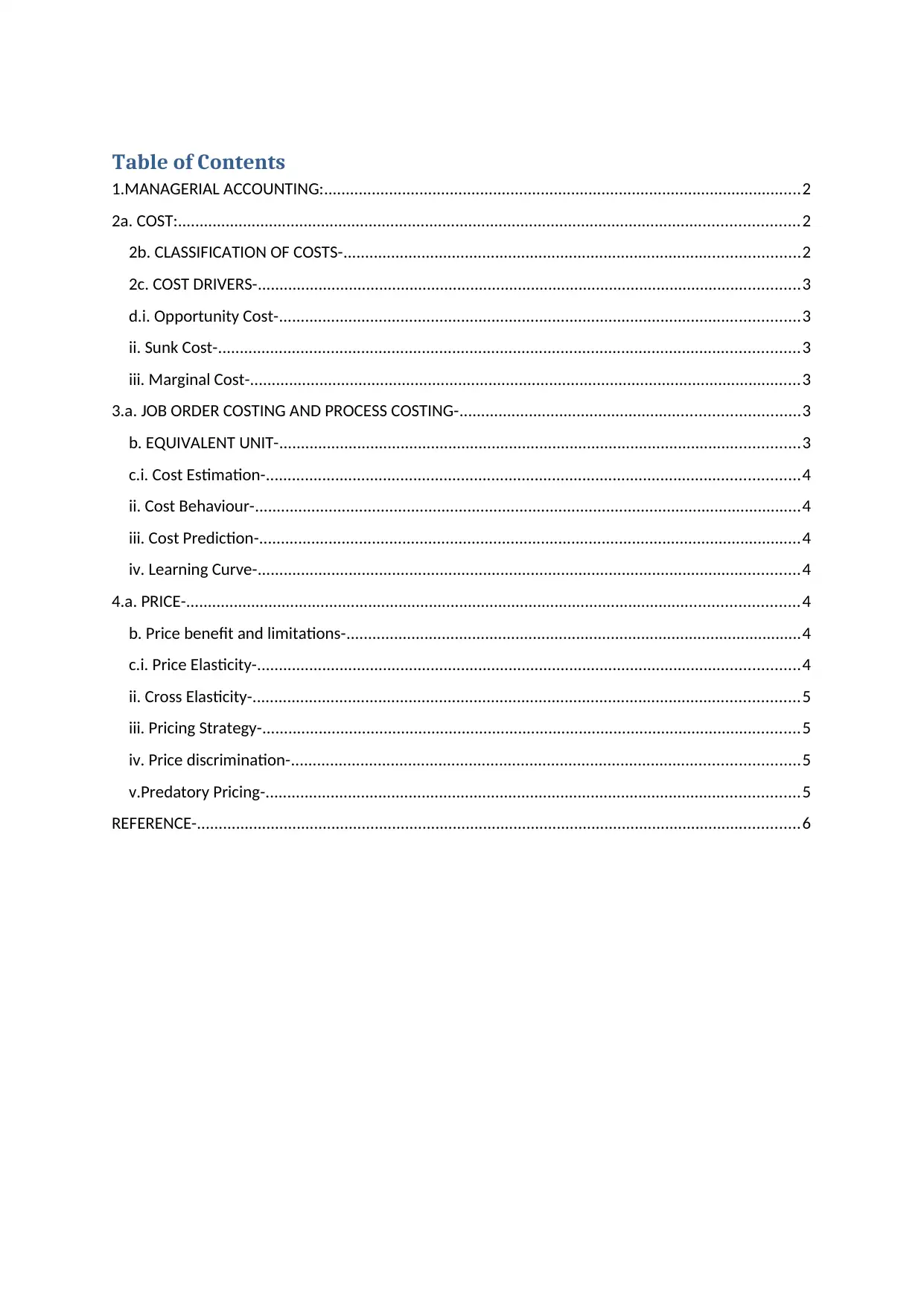
Table of Contents
1.MANAGERIAL ACCOUNTING:..............................................................................................................2
2a. COST:...............................................................................................................................................2
2b. CLASSIFICATION OF COSTS-.........................................................................................................2
2c. COST DRIVERS-.............................................................................................................................3
d.i. Opportunity Cost-........................................................................................................................3
ii. Sunk Cost-......................................................................................................................................3
iii. Marginal Cost-...............................................................................................................................3
3.a. JOB ORDER COSTING AND PROCESS COSTING-..............................................................................3
b. EQUIVALENT UNIT-........................................................................................................................3
c.i. Cost Estimation-...........................................................................................................................4
ii. Cost Behaviour-..............................................................................................................................4
iii. Cost Prediction-.............................................................................................................................4
iv. Learning Curve-.............................................................................................................................4
4.a. PRICE-.............................................................................................................................................4
b. Price benefit and limitations-.........................................................................................................4
c.i. Price Elasticity-.............................................................................................................................4
ii. Cross Elasticity-..............................................................................................................................5
iii. Pricing Strategy-............................................................................................................................5
iv. Price discrimination-.....................................................................................................................5
v.Predatory Pricing-...........................................................................................................................5
REFERENCE-...........................................................................................................................................6
1.MANAGERIAL ACCOUNTING:..............................................................................................................2
2a. COST:...............................................................................................................................................2
2b. CLASSIFICATION OF COSTS-.........................................................................................................2
2c. COST DRIVERS-.............................................................................................................................3
d.i. Opportunity Cost-........................................................................................................................3
ii. Sunk Cost-......................................................................................................................................3
iii. Marginal Cost-...............................................................................................................................3
3.a. JOB ORDER COSTING AND PROCESS COSTING-..............................................................................3
b. EQUIVALENT UNIT-........................................................................................................................3
c.i. Cost Estimation-...........................................................................................................................4
ii. Cost Behaviour-..............................................................................................................................4
iii. Cost Prediction-.............................................................................................................................4
iv. Learning Curve-.............................................................................................................................4
4.a. PRICE-.............................................................................................................................................4
b. Price benefit and limitations-.........................................................................................................4
c.i. Price Elasticity-.............................................................................................................................4
ii. Cross Elasticity-..............................................................................................................................5
iii. Pricing Strategy-............................................................................................................................5
iv. Price discrimination-.....................................................................................................................5
v.Predatory Pricing-...........................................................................................................................5
REFERENCE-...........................................................................................................................................6
Paraphrase This Document
Need a fresh take? Get an instant paraphrase of this document with our AI Paraphraser
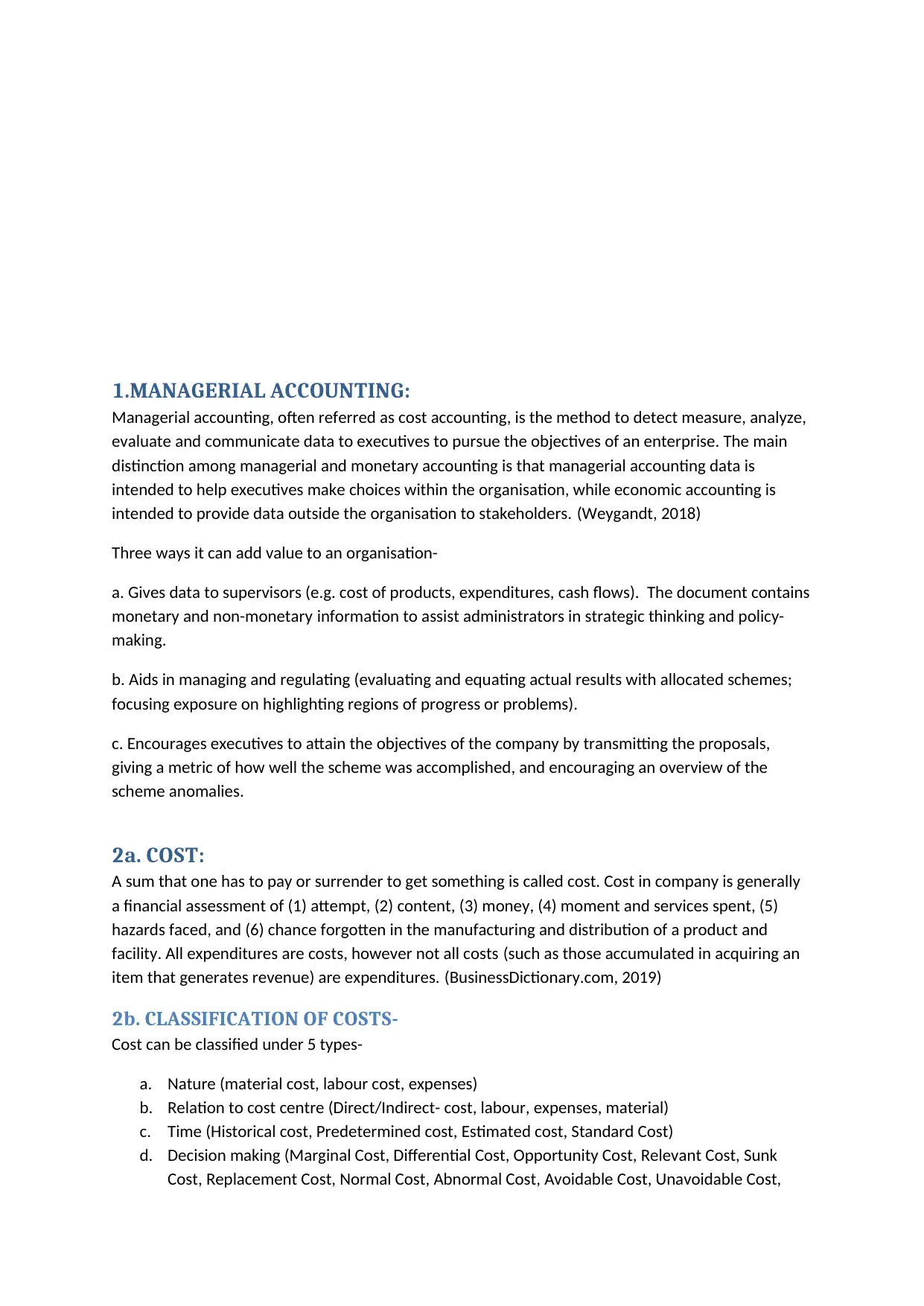
1.MANAGERIAL ACCOUNTING:
Managerial accounting, often referred as cost accounting, is the method to detect measure, analyze,
evaluate and communicate data to executives to pursue the objectives of an enterprise. The main
distinction among managerial and monetary accounting is that managerial accounting data is
intended to help executives make choices within the organisation, while economic accounting is
intended to provide data outside the organisation to stakeholders. (Weygandt, 2018)
Three ways it can add value to an organisation-
a. Gives data to supervisors (e.g. cost of products, expenditures, cash flows). The document contains
monetary and non-monetary information to assist administrators in strategic thinking and policy-
making.
b. Aids in managing and regulating (evaluating and equating actual results with allocated schemes;
focusing exposure on highlighting regions of progress or problems).
c. Encourages executives to attain the objectives of the company by transmitting the proposals,
giving a metric of how well the scheme was accomplished, and encouraging an overview of the
scheme anomalies.
2a. COST:
A sum that one has to pay or surrender to get something is called cost. Cost in company is generally
a financial assessment of (1) attempt, (2) content, (3) money, (4) moment and services spent, (5)
hazards faced, and (6) chance forgotten in the manufacturing and distribution of a product and
facility. All expenditures are costs, however not all costs (such as those accumulated in acquiring an
item that generates revenue) are expenditures. (BusinessDictionary.com, 2019)
2b. CLASSIFICATION OF COSTS-
Cost can be classified under 5 types-
a. Nature (material cost, labour cost, expenses)
b. Relation to cost centre (Direct/Indirect- cost, labour, expenses, material)
c. Time (Historical cost, Predetermined cost, Estimated cost, Standard Cost)
d. Decision making (Marginal Cost, Differential Cost, Opportunity Cost, Relevant Cost, Sunk
Cost, Replacement Cost, Normal Cost, Abnormal Cost, Avoidable Cost, Unavoidable Cost,
Managerial accounting, often referred as cost accounting, is the method to detect measure, analyze,
evaluate and communicate data to executives to pursue the objectives of an enterprise. The main
distinction among managerial and monetary accounting is that managerial accounting data is
intended to help executives make choices within the organisation, while economic accounting is
intended to provide data outside the organisation to stakeholders. (Weygandt, 2018)
Three ways it can add value to an organisation-
a. Gives data to supervisors (e.g. cost of products, expenditures, cash flows). The document contains
monetary and non-monetary information to assist administrators in strategic thinking and policy-
making.
b. Aids in managing and regulating (evaluating and equating actual results with allocated schemes;
focusing exposure on highlighting regions of progress or problems).
c. Encourages executives to attain the objectives of the company by transmitting the proposals,
giving a metric of how well the scheme was accomplished, and encouraging an overview of the
scheme anomalies.
2a. COST:
A sum that one has to pay or surrender to get something is called cost. Cost in company is generally
a financial assessment of (1) attempt, (2) content, (3) money, (4) moment and services spent, (5)
hazards faced, and (6) chance forgotten in the manufacturing and distribution of a product and
facility. All expenditures are costs, however not all costs (such as those accumulated in acquiring an
item that generates revenue) are expenditures. (BusinessDictionary.com, 2019)
2b. CLASSIFICATION OF COSTS-
Cost can be classified under 5 types-
a. Nature (material cost, labour cost, expenses)
b. Relation to cost centre (Direct/Indirect- cost, labour, expenses, material)
c. Time (Historical cost, Predetermined cost, Estimated cost, Standard Cost)
d. Decision making (Marginal Cost, Differential Cost, Opportunity Cost, Relevant Cost, Sunk
Cost, Replacement Cost, Normal Cost, Abnormal Cost, Avoidable Cost, Unavoidable Cost,
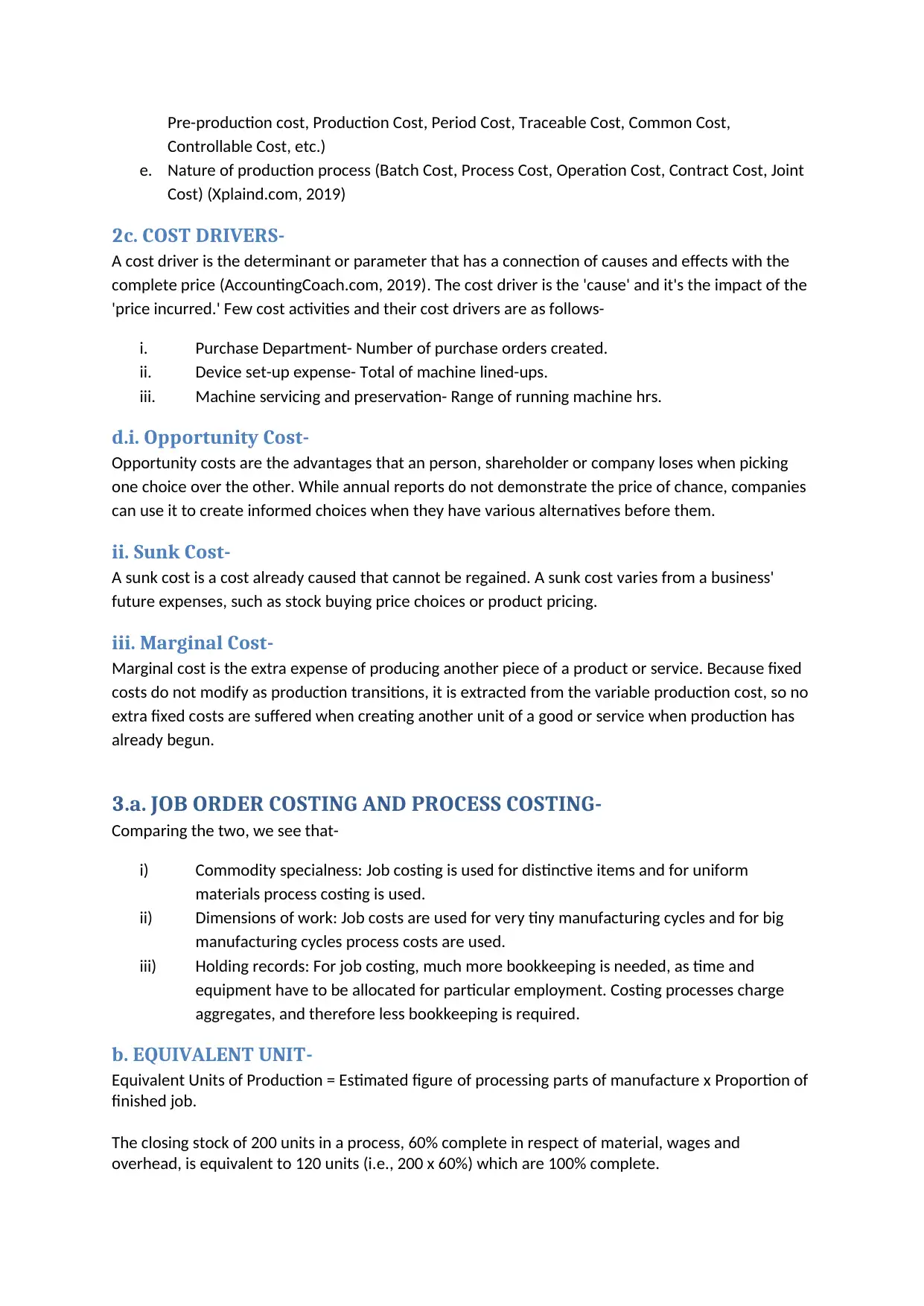
Pre-production cost, Production Cost, Period Cost, Traceable Cost, Common Cost,
Controllable Cost, etc.)
e. Nature of production process (Batch Cost, Process Cost, Operation Cost, Contract Cost, Joint
Cost) (Xplaind.com, 2019)
2c. COST DRIVERS-
A cost driver is the determinant or parameter that has a connection of causes and effects with the
complete price (AccountingCoach.com, 2019). The cost driver is the 'cause' and it's the impact of the
'price incurred.' Few cost activities and their cost drivers are as follows-
i. Purchase Department- Number of purchase orders created.
ii. Device set-up expense- Total of machine lined-ups.
iii. Machine servicing and preservation- Range of running machine hrs.
d.i. Opportunity Cost-
Opportunity costs are the advantages that an person, shareholder or company loses when picking
one choice over the other. While annual reports do not demonstrate the price of chance, companies
can use it to create informed choices when they have various alternatives before them.
ii. Sunk Cost-
A sunk cost is a cost already caused that cannot be regained. A sunk cost varies from a business'
future expenses, such as stock buying price choices or product pricing.
iii. Marginal Cost-
Marginal cost is the extra expense of producing another piece of a product or service. Because fixed
costs do not modify as production transitions, it is extracted from the variable production cost, so no
extra fixed costs are suffered when creating another unit of a good or service when production has
already begun.
3.a. JOB ORDER COSTING AND PROCESS COSTING-
Comparing the two, we see that-
i) Commodity specialness: Job costing is used for distinctive items and for uniform
materials process costing is used.
ii) Dimensions of work: Job costs are used for very tiny manufacturing cycles and for big
manufacturing cycles process costs are used.
iii) Holding records: For job costing, much more bookkeeping is needed, as time and
equipment have to be allocated for particular employment. Costing processes charge
aggregates, and therefore less bookkeeping is required.
b. EQUIVALENT UNIT-
Equivalent Units of Production = Estimated figure of processing parts of manufacture x Proportion of
finished job.
The closing stock of 200 units in a process, 60% complete in respect of material, wages and
overhead, is equivalent to 120 units (i.e., 200 x 60%) which are 100% complete.
Controllable Cost, etc.)
e. Nature of production process (Batch Cost, Process Cost, Operation Cost, Contract Cost, Joint
Cost) (Xplaind.com, 2019)
2c. COST DRIVERS-
A cost driver is the determinant or parameter that has a connection of causes and effects with the
complete price (AccountingCoach.com, 2019). The cost driver is the 'cause' and it's the impact of the
'price incurred.' Few cost activities and their cost drivers are as follows-
i. Purchase Department- Number of purchase orders created.
ii. Device set-up expense- Total of machine lined-ups.
iii. Machine servicing and preservation- Range of running machine hrs.
d.i. Opportunity Cost-
Opportunity costs are the advantages that an person, shareholder or company loses when picking
one choice over the other. While annual reports do not demonstrate the price of chance, companies
can use it to create informed choices when they have various alternatives before them.
ii. Sunk Cost-
A sunk cost is a cost already caused that cannot be regained. A sunk cost varies from a business'
future expenses, such as stock buying price choices or product pricing.
iii. Marginal Cost-
Marginal cost is the extra expense of producing another piece of a product or service. Because fixed
costs do not modify as production transitions, it is extracted from the variable production cost, so no
extra fixed costs are suffered when creating another unit of a good or service when production has
already begun.
3.a. JOB ORDER COSTING AND PROCESS COSTING-
Comparing the two, we see that-
i) Commodity specialness: Job costing is used for distinctive items and for uniform
materials process costing is used.
ii) Dimensions of work: Job costs are used for very tiny manufacturing cycles and for big
manufacturing cycles process costs are used.
iii) Holding records: For job costing, much more bookkeeping is needed, as time and
equipment have to be allocated for particular employment. Costing processes charge
aggregates, and therefore less bookkeeping is required.
b. EQUIVALENT UNIT-
Equivalent Units of Production = Estimated figure of processing parts of manufacture x Proportion of
finished job.
The closing stock of 200 units in a process, 60% complete in respect of material, wages and
overhead, is equivalent to 120 units (i.e., 200 x 60%) which are 100% complete.
You're viewing a preview
Unlock full access by subscribing today!
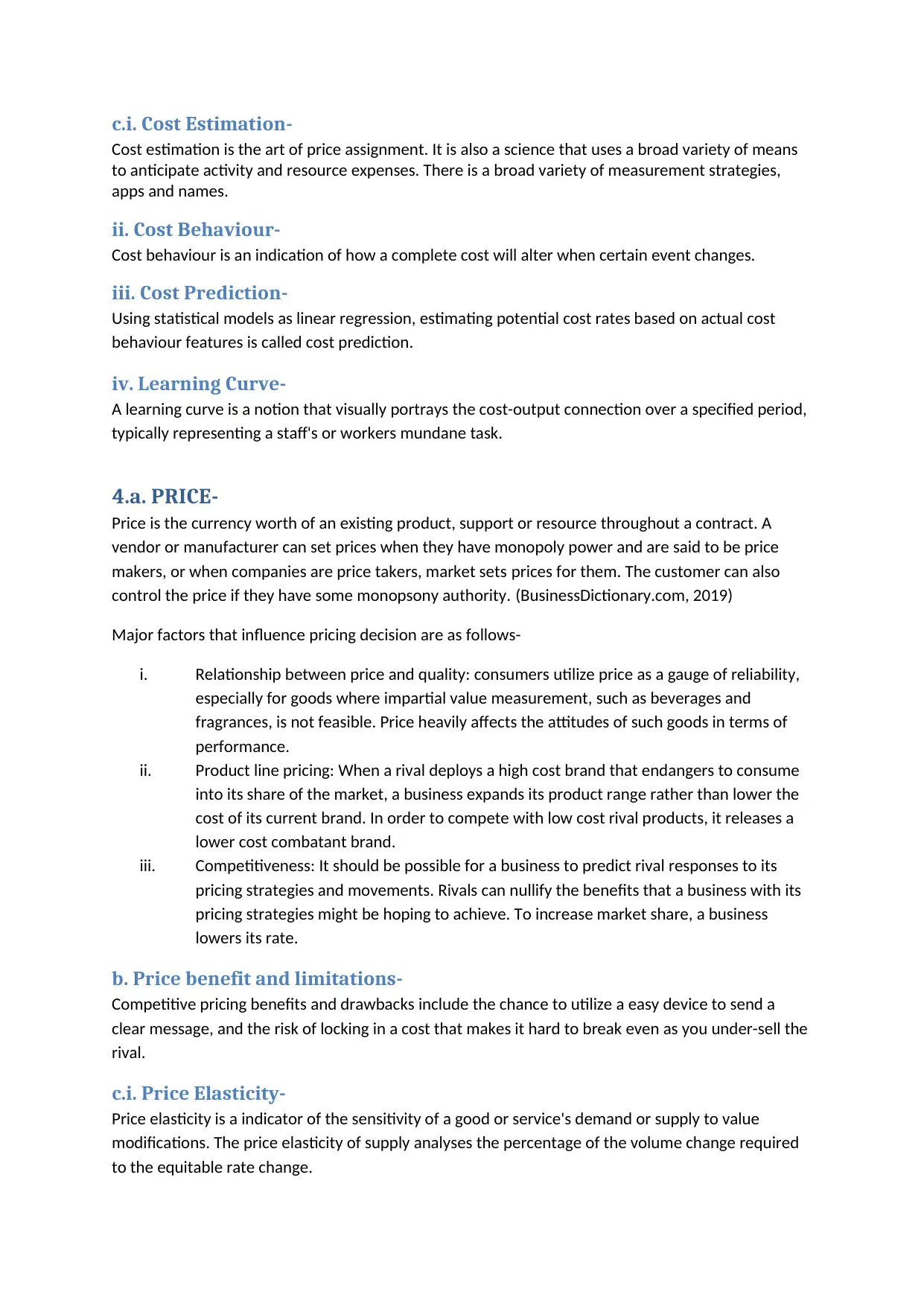
c.i. Cost Estimation-
Cost estimation is the art of price assignment. It is also a science that uses a broad variety of means
to anticipate activity and resource expenses. There is a broad variety of measurement strategies,
apps and names.
ii. Cost Behaviour-
Cost behaviour is an indication of how a complete cost will alter when certain event changes.
iii. Cost Prediction-
Using statistical models as linear regression, estimating potential cost rates based on actual cost
behaviour features is called cost prediction.
iv. Learning Curve-
A learning curve is a notion that visually portrays the cost-output connection over a specified period,
typically representing a staff's or workers mundane task.
4.a. PRICE-
Price is the currency worth of an existing product, support or resource throughout a contract. A
vendor or manufacturer can set prices when they have monopoly power and are said to be price
makers, or when companies are price takers, market sets prices for them. The customer can also
control the price if they have some monopsony authority. (BusinessDictionary.com, 2019)
Major factors that influence pricing decision are as follows-
i. Relationship between price and quality: consumers utilize price as a gauge of reliability,
especially for goods where impartial value measurement, such as beverages and
fragrances, is not feasible. Price heavily affects the attitudes of such goods in terms of
performance.
ii. Product line pricing: When a rival deploys a high cost brand that endangers to consume
into its share of the market, a business expands its product range rather than lower the
cost of its current brand. In order to compete with low cost rival products, it releases a
lower cost combatant brand.
iii. Competitiveness: It should be possible for a business to predict rival responses to its
pricing strategies and movements. Rivals can nullify the benefits that a business with its
pricing strategies might be hoping to achieve. To increase market share, a business
lowers its rate.
b. Price benefit and limitations-
Competitive pricing benefits and drawbacks include the chance to utilize a easy device to send a
clear message, and the risk of locking in a cost that makes it hard to break even as you under-sell the
rival.
c.i. Price Elasticity-
Price elasticity is a indicator of the sensitivity of a good or service's demand or supply to value
modifications. The price elasticity of supply analyses the percentage of the volume change required
to the equitable rate change.
Cost estimation is the art of price assignment. It is also a science that uses a broad variety of means
to anticipate activity and resource expenses. There is a broad variety of measurement strategies,
apps and names.
ii. Cost Behaviour-
Cost behaviour is an indication of how a complete cost will alter when certain event changes.
iii. Cost Prediction-
Using statistical models as linear regression, estimating potential cost rates based on actual cost
behaviour features is called cost prediction.
iv. Learning Curve-
A learning curve is a notion that visually portrays the cost-output connection over a specified period,
typically representing a staff's or workers mundane task.
4.a. PRICE-
Price is the currency worth of an existing product, support or resource throughout a contract. A
vendor or manufacturer can set prices when they have monopoly power and are said to be price
makers, or when companies are price takers, market sets prices for them. The customer can also
control the price if they have some monopsony authority. (BusinessDictionary.com, 2019)
Major factors that influence pricing decision are as follows-
i. Relationship between price and quality: consumers utilize price as a gauge of reliability,
especially for goods where impartial value measurement, such as beverages and
fragrances, is not feasible. Price heavily affects the attitudes of such goods in terms of
performance.
ii. Product line pricing: When a rival deploys a high cost brand that endangers to consume
into its share of the market, a business expands its product range rather than lower the
cost of its current brand. In order to compete with low cost rival products, it releases a
lower cost combatant brand.
iii. Competitiveness: It should be possible for a business to predict rival responses to its
pricing strategies and movements. Rivals can nullify the benefits that a business with its
pricing strategies might be hoping to achieve. To increase market share, a business
lowers its rate.
b. Price benefit and limitations-
Competitive pricing benefits and drawbacks include the chance to utilize a easy device to send a
clear message, and the risk of locking in a cost that makes it hard to break even as you under-sell the
rival.
c.i. Price Elasticity-
Price elasticity is a indicator of the sensitivity of a good or service's demand or supply to value
modifications. The price elasticity of supply analyses the percentage of the volume change required
to the equitable rate change.
Paraphrase This Document
Need a fresh take? Get an instant paraphrase of this document with our AI Paraphraser
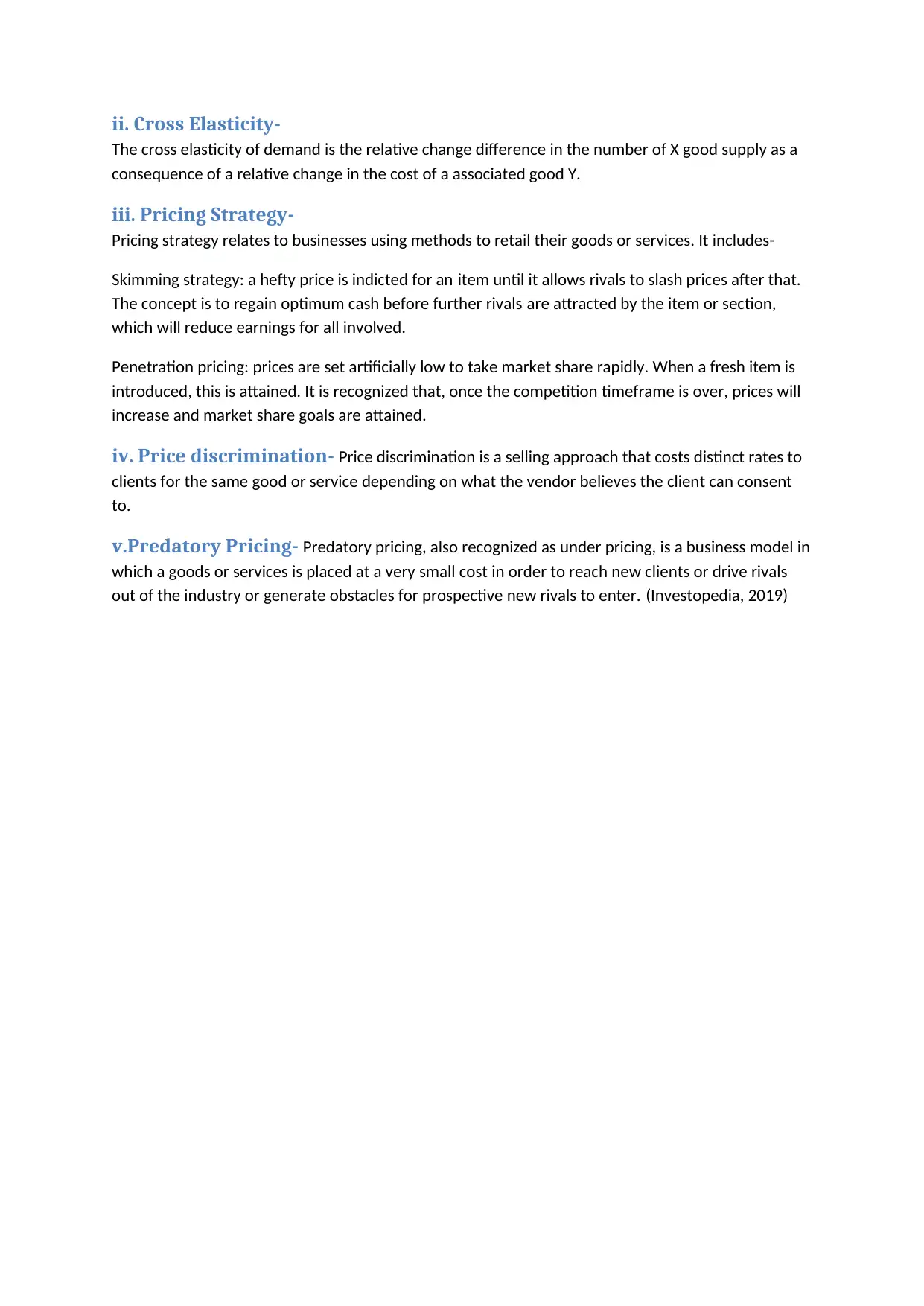
ii. Cross Elasticity-
The cross elasticity of demand is the relative change difference in the number of X good supply as a
consequence of a relative change in the cost of a associated good Y.
iii. Pricing Strategy-
Pricing strategy relates to businesses using methods to retail their goods or services. It includes-
Skimming strategy: a hefty price is indicted for an item until it allows rivals to slash prices after that.
The concept is to regain optimum cash before further rivals are attracted by the item or section,
which will reduce earnings for all involved.
Penetration pricing: prices are set artificially low to take market share rapidly. When a fresh item is
introduced, this is attained. It is recognized that, once the competition timeframe is over, prices will
increase and market share goals are attained.
iv. Price discrimination- Price discrimination is a selling approach that costs distinct rates to
clients for the same good or service depending on what the vendor believes the client can consent
to.
v.Predatory Pricing- Predatory pricing, also recognized as under pricing, is a business model in
which a goods or services is placed at a very small cost in order to reach new clients or drive rivals
out of the industry or generate obstacles for prospective new rivals to enter. (Investopedia, 2019)
The cross elasticity of demand is the relative change difference in the number of X good supply as a
consequence of a relative change in the cost of a associated good Y.
iii. Pricing Strategy-
Pricing strategy relates to businesses using methods to retail their goods or services. It includes-
Skimming strategy: a hefty price is indicted for an item until it allows rivals to slash prices after that.
The concept is to regain optimum cash before further rivals are attracted by the item or section,
which will reduce earnings for all involved.
Penetration pricing: prices are set artificially low to take market share rapidly. When a fresh item is
introduced, this is attained. It is recognized that, once the competition timeframe is over, prices will
increase and market share goals are attained.
iv. Price discrimination- Price discrimination is a selling approach that costs distinct rates to
clients for the same good or service depending on what the vendor believes the client can consent
to.
v.Predatory Pricing- Predatory pricing, also recognized as under pricing, is a business model in
which a goods or services is placed at a very small cost in order to reach new clients or drive rivals
out of the industry or generate obstacles for prospective new rivals to enter. (Investopedia, 2019)
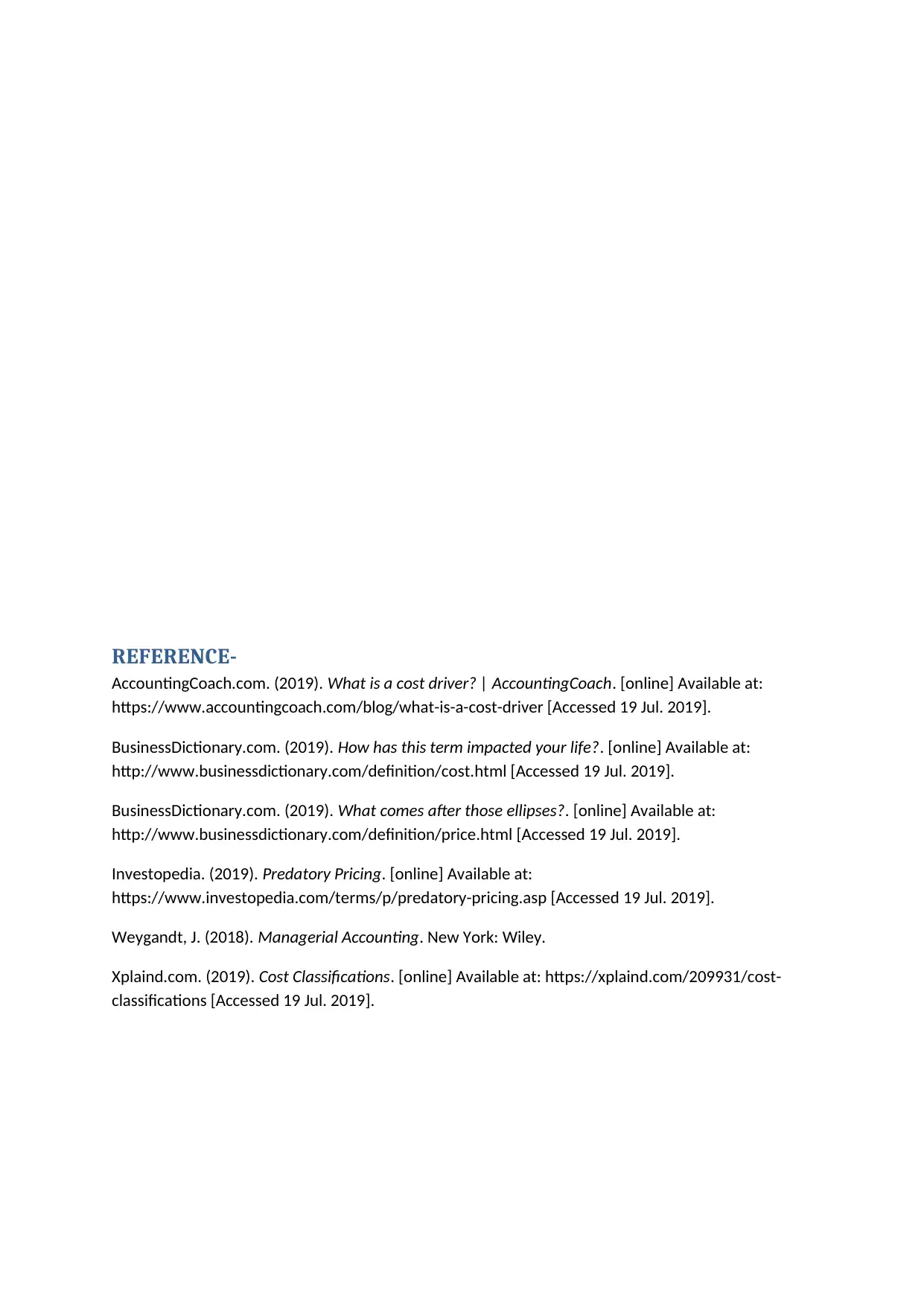
REFERENCE-
AccountingCoach.com. (2019). What is a cost driver? | AccountingCoach. [online] Available at:
https://www.accountingcoach.com/blog/what-is-a-cost-driver [Accessed 19 Jul. 2019].
BusinessDictionary.com. (2019). How has this term impacted your life?. [online] Available at:
http://www.businessdictionary.com/definition/cost.html [Accessed 19 Jul. 2019].
BusinessDictionary.com. (2019). What comes after those ellipses?. [online] Available at:
http://www.businessdictionary.com/definition/price.html [Accessed 19 Jul. 2019].
Investopedia. (2019). Predatory Pricing. [online] Available at:
https://www.investopedia.com/terms/p/predatory-pricing.asp [Accessed 19 Jul. 2019].
Weygandt, J. (2018). Managerial Accounting. New York: Wiley.
Xplaind.com. (2019). Cost Classifications. [online] Available at: https://xplaind.com/209931/cost-
classifications [Accessed 19 Jul. 2019].
AccountingCoach.com. (2019). What is a cost driver? | AccountingCoach. [online] Available at:
https://www.accountingcoach.com/blog/what-is-a-cost-driver [Accessed 19 Jul. 2019].
BusinessDictionary.com. (2019). How has this term impacted your life?. [online] Available at:
http://www.businessdictionary.com/definition/cost.html [Accessed 19 Jul. 2019].
BusinessDictionary.com. (2019). What comes after those ellipses?. [online] Available at:
http://www.businessdictionary.com/definition/price.html [Accessed 19 Jul. 2019].
Investopedia. (2019). Predatory Pricing. [online] Available at:
https://www.investopedia.com/terms/p/predatory-pricing.asp [Accessed 19 Jul. 2019].
Weygandt, J. (2018). Managerial Accounting. New York: Wiley.
Xplaind.com. (2019). Cost Classifications. [online] Available at: https://xplaind.com/209931/cost-
classifications [Accessed 19 Jul. 2019].
You're viewing a preview
Unlock full access by subscribing today!
1 out of 6
Related Documents
Your All-in-One AI-Powered Toolkit for Academic Success.
+13062052269
info@desklib.com
Available 24*7 on WhatsApp / Email
![[object Object]](/_next/static/media/star-bottom.7253800d.svg)
Unlock your academic potential
© 2024 | Zucol Services PVT LTD | All rights reserved.




